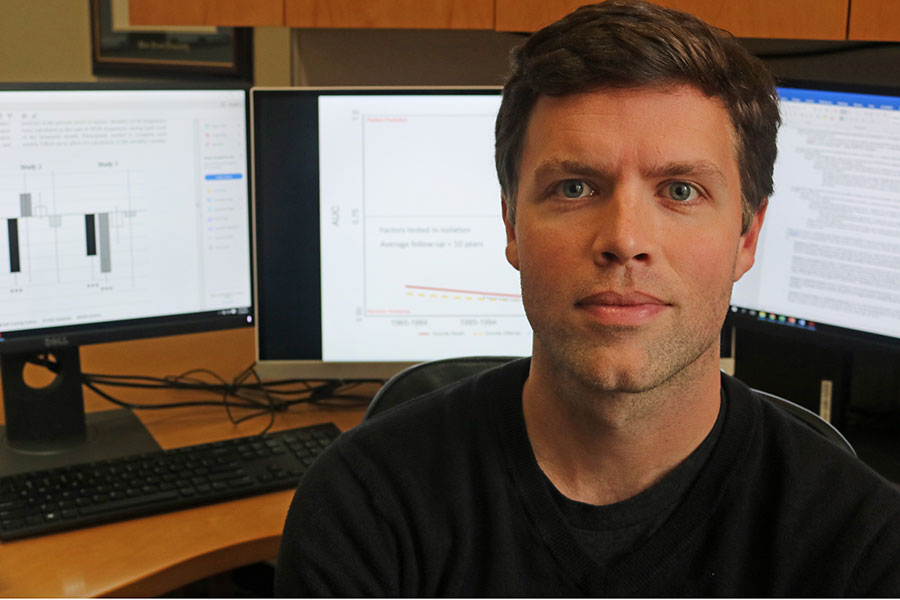
Florida State University researcher Joseph Franklin made a startling discovery during an exhaustive examination of hundreds of suicide prediction studies conducted over the past 50 years:
Science is still not very good at predicting who will kill themselves.
In a new study published today in the journal Psychological Bulletin, Franklin and his colleagues found traditional risk factors — such as depression, substance abuse, stress or previous suicide attempts — were not good predictors of suicide.
“Nothing was better than chance,” said Franklin, assistant professor of psychology at Florida State. “It’s like you guessing, or flipping a coin, is as good as the best suicide expert in the world who has all the information about a person’s life. That was pretty sobering for us and sobering for the field because it says all the stuff we’ve been doing for the past 50 years hasn’t produced any real progress in terms of prediction.”
That lack of progress is highlighted by the facts: Suicide rates in the United States are at their highest levels in 30 years. More than 40,000 Americans will kill themselves this year. Every day, 117 people take their own lives.
If you compare historical rates for suicide, homicide and car deaths, you find a disturbing truth: In the 1970s, you were more likely to be killed by someone else or in a car crash than to kill yourself. Today, with tougher crime laws and better car safety features, the opposite is true. You are far more likely to die by your own hand.
Franklin’s project — a meta-analysis of 365 suicide studies — found past research was flawed because it typically focused on a single risk factor, such as depression or low serotonin in the brain, and then followed patients over a decade. That type of long-term approach produced incomplete risk factors that did not accurately identify who needed mental health assistance.
Franklin completed the research as a postdoctoral fellow at Harvard University. He and his colleagues — Jessica Ribeiro, faculty researcher in FSU’s department of psychology and Colin Walsh, assistant professor at Vanderbilt University — want to change the way someone is determined to be at risk for suicide. They think a shorter-term method, using artificial intelligence, will produce more accurate risk factors.
That’s why they are testing a “machine-learning” method employing algorithms to identify risk factors for suicidal behavior.
Franklin compared it to the Google search algorithm that combines hundreds of factors based on personal search history, and more, to find accurate results. The machine-learning method combines hundreds of factors from a person’s health history to improve the accuracy of suicide prediction. This method can easily be implemented across large hospital networks with millions of patients.
“This work is still in progress, but it represents a huge advance in a short amount of time,” Franklin said. “We believe this line of work will take us from ‘I have no idea’ to ‘I can tell you pretty strongly that this is going to happen.’”
Then, once more accurate risk factors are identified, Franklin hopes to expand the use of new technology to battle suicide and mental illness on a large scale.
The team of researchers has already developed a free web app that’s proven effective in trials at reducing suicidal behaviors. The app, called “Tec-Tec,” is available on iTunes and Amazon right now. Franklin hopes millions of people will eventually use it.
“Our studies so far have shown that the app alone reduced suicidal behaviors by about 50 percent over the course of a month in hundreds of people,” Franklin said. “And it’s free, so anyone can have access to this treatment that can work pretty well at no cost. It’s an example of something you can create that may be effective and could be available to anyone with internet access.”
Franklin brings a can-do attitude to these goals: Better understand the causes of suicide and predict who will develop suicidal behaviors with an accuracy rate near 100 percent.
“If you can do that with millions of people, then you can make population-level impacts on these things,” he said.
As for current suicide risk factors, Franklin warned against discarding them. He recommended therapists continue using the guidelines but said there’s an urgent need to re-evaluate them.
The study published today, “Risk Factors for Suicidal Thoughts and Behaviors: A Meta-Analysis of 50 Years of Research,” included contributions from Ribeiro; Kathryn R. Fox, Evan M. Kleiman, Adam C. Jaroszewski, and Matthew K. Nock, all of Harvard University; Xieyining Huang and Katherine M. Musacchio of Vanderbilt University; Bernard P. Chang of Columbia University Medical Center; and Kate H. Bentley of Boston University.
It was funded in part by the Military Suicide Research Consortium. Additional funding was provided by the John D. and Catherine T. MacArthur Foundation.




